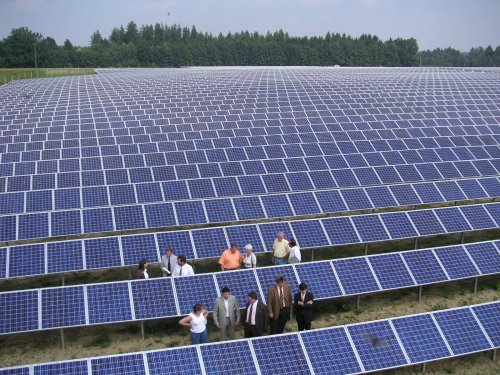How’s this for a stumper?
The Toronto Star has an article about the debate about solar farm development on prime agricultural land under the new Green Energy Act FIT rates. Short summary, solar industry types (led by CanSIA) and farmers hoping to develop some of their land into solar farms are protesting rules for Feed-in tariffs that will restrict solar development on prime agricultural land.
Weirdly enough, it’s a debate where everyone is right, their position is reasonable and none of the claims really run counter to the others. Strange. This is my very over-simplified version of the positions and stakeholders:
Farmers: It’s their land and they can do what they damn well please with it. If they can make more money by turning the land over to electrical production for 20-25 years, no one should have the right to stop them. The land isn’t harmed, the soil and ground water isn’t contaminated, and the potential outcome of leaving the land fallow for that long could be to significantly improve the potential yield of the land in the future.
Solar Energy Industry Types: The amount of farm land that might end up being used for solar energy around 1/10th of 1%, but this represents the small number of very large scale projects that Ontario’s Solar Energy Industry really needs to develop the scale required to become internationally competitive. Banning or limiting these projects will diminish the success of Ontario Solar companies and entrepreneurs, and it will cost Ontario many high value green jobs.
Government, Farm minded people & Environmentalists: Prime agricultural land should be used to grow food, solar energy development should take place elsewhere (rooftops, low quality land etc). They want to avoid this:
When I first considered this, I thought that they should include an exemption for solar farm development that uses sun trackers – that is, allow this:
At first, my take was, allow this:

Dual Land Use - Solar Panels installed using sun trackers on a farm in Spain, farm is still producing food.
Trackers allow for the land to continue to be used for agriculture, can co-exist with pasture land easily, and are ideal for putting allot of solar power into small spaces like the wind-breaks between fields. Also, they’re a fairly mature technology with lots of expired patents, so any metal shop that could make an automotive frame can make the things fairly easily. Lots of the companies on the market don’t actually ship the trackers, they ship the controller that detects the sun and controls the movement, and licence the design and manufacturer to local contractors.
As an added benefit, you get significantly more power per day from the same panels because they’re kept at the optimum angle to the sun (where as fixed panels like the ones in the first picture are close to optimum only for an hour or so each day). Field results from tracking vary, but 40% to 50% more energy for the same panels is a safe number to use as a ball park when going from fixed to tracking systems. With an efficient panel, the extra value of the energy can more than pay for the cost of installing and maintaining the panel, especially in Ontario with the feed-in tariff.
However, thinking on it a little more, I’m not sure I’d actually want to see an exemption specifically for trackers if the ban on farm development went through.
That puts the government in the position of picking and choosing technologies (and defining what is and isn’t a tracker) and it stifles innovation. Instead, it seems reasonable to require that solar farm projects should not use more than a specific amount of any given farmer’s usable farm land. Nobody would argue that a farmer shouldn’t have panels on his roof, and it follows that a small row of panels along the wind break between fields or a few sun trackers in among a cattle pasture wouldn’t be something we’d want to ban either.
But it’s less clear what the rule should be if a farmer with 200 arces wants to turn 4 of them into a solar farm. It’s 2% of that farmer’s land, but could end up contributing significantly more than than 2% to his income.
It’s not a clear cut issue, and whatever the Ministry of Energy and Infrastructure decide, if they’re smart (they are) they’ll keep it simple, won’t pick and choose winners, technologies and won’t ban anything – rather, they’ll put a reasonable and transparent process where solar development on agricultural land is considered on a case by case basis, with clear guidelines of what the goals of the process are. The occasional project that plans to completely cover hundreds of acres of farm land will know that it has a high bar to to jump, and the farmer than wants to turn a pasture into a little extra profit won’t have to worry.


You must be logged in to post a comment.